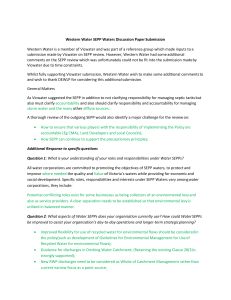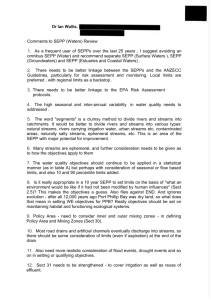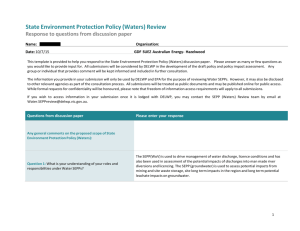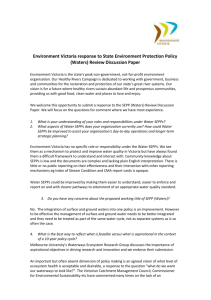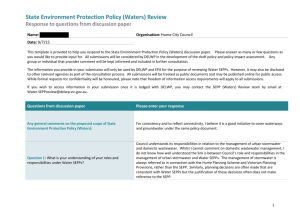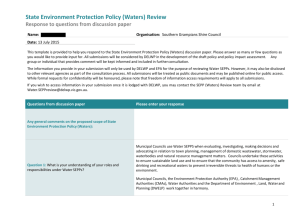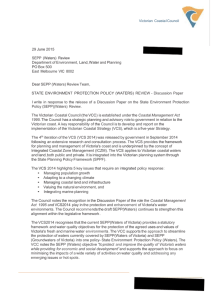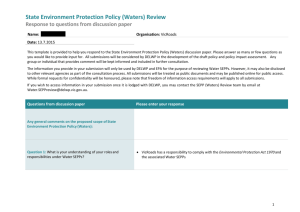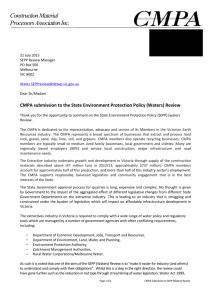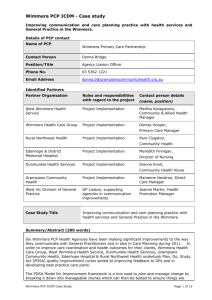Wimmera CMA - Department of Environment, Land, Water and
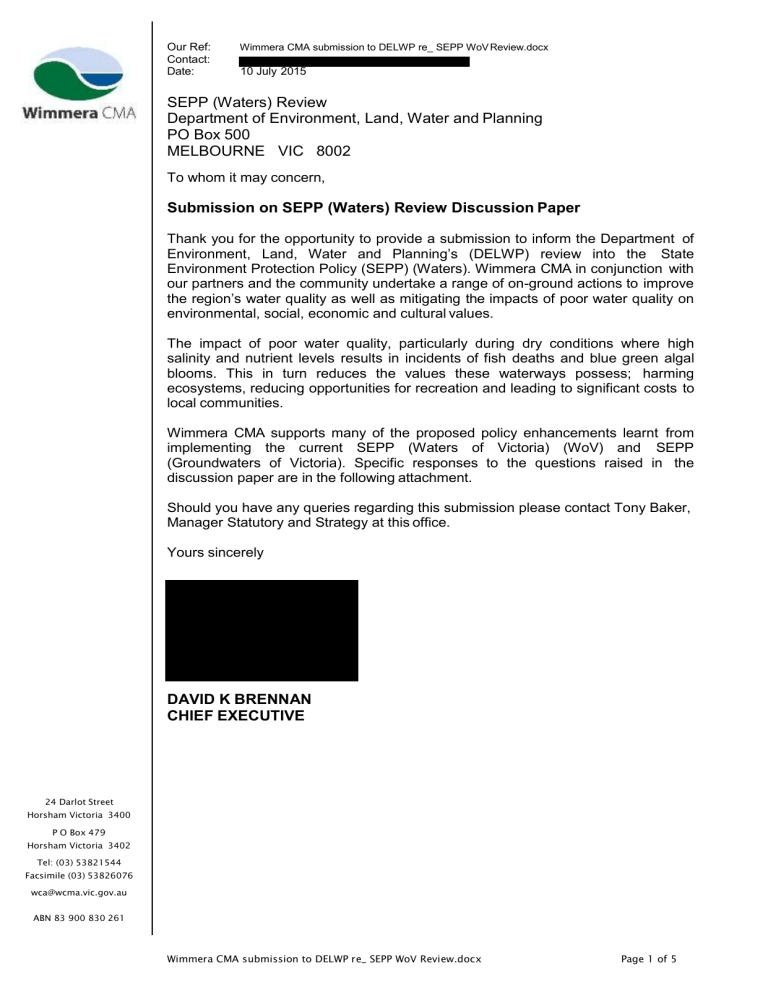
Our Ref: Wimmera CMA submission to DELWP re_ SEPP WoV Review.docx
Contact:
Date: 10 July 2015
SEPP (Waters) Review
Department of Environment, Land, Water and Planning
PO Box 500
MELBOURNE VIC 8002
To whom it may concern,
Submission on SEPP (Waters) Review Discussion Paper
Thank you for the opportunity to provide a submission to inform the Department of
Environment , Land, Water and Planning’s (DELWP) review into the State
Environment Protection Policy (SEPP) (Waters). Wimmera CMA in conjunction with our partners and the community undertake a range of on-ground actions to improve the region’s water quality as well as mitigating the impacts of poor water quality on environmental, social, economic and cultural values.
The impact of poor water quality, particularly during dry conditions where high salinity and nutrient levels results in incidents of fish deaths and blue green algal blooms. This in turn reduces the values these waterways possess; harming ecosystems, reducing opportunities for recreation and leading to significant costs to local communities.
Wimmera CMA supports many of the proposed policy enhancements learnt from implementing the current SEPP (Waters of Victoria) (WoV) and SEPP
(Groundwaters of Victoria). Specific responses to the questions raised in the discussion paper are in the following attachment.
Should you have any queries regarding this submission please contact Tony Baker,
Manager Statutory and Strategy at this office.
Yours sincerely
24 Darlot Street
Horsham Victoria 3400
P O Box 479
Horsham Victoria 3402
Tel: (03) 53821544
Facsimile (03) 53826076 wca@wcma.vic.gov.au
ABN 83 900 830 261
DAVID K BRENNAN
CHIEF EXECUTIVE
Wimmera CMA submission to DELWP re_ SEPP WoV Review.docx Page 1 of 5
Attachment – Responses to Questions
Question 1: What is your understanding of your roles and responsibilities under
Water SEPPs?
Wimmera CMA develops strategic plans such as regional catchment strategies and waterway strategies that establish goals and targets for improved water quality.
Under these goals and targets sit a number of management activities such as riparian maintenance and improvement works. Through obtaining funding from state and federal governments, these management activities can be implemented in conjunction with partners and the community.
Question 2: What aspects of Water SEPPs does your organisation currently use?
How could Water SEPPs be improved to assist you r o rga n isa t ion
’s da y -to-day operations and longer-term strategic planning?
The SEPP (WoV) is used on an ongoing basis for benchmarking water quality monitoring undertaken by the Wimmera CMA. It is also used for target and objective setting in strategies and plans such as the Wimmera Waterway Strategy
2014-2022 (Wimmera CMA, 2014) and Wimmera River Environmental Flows Study
(Alluvium, 2013).
In the past the SEPP (WoV) has been used to benchmark macroinvertebrate communities, for example EPA Victoria & Wimmera CMA (2008) and assisted in terms of annual and periodic reporting on overall waterway condition. Providing a comparison against SEPP (WoV) objectives highlighted the substantial declines in the condition of the Wimmera River and its tributaries during the Millennium
Drought and the positive impact of increased flows, in particular through environmental watering.
It should be noted that the Index of Stream Condition assessments covered in the discussion paper were undertaken during the midst of record drought conditions and so failure to meet SEPP (WoV) objectives during this time is not necessarily a an issue with the objectives themselves given their long-term, aspirational status.
Question 3: Do you have any concerns about the proposed working title of State
Environment Protection Policy (Waters)? If so, what are they?
No comment.
Question 4: What is the best way to reflect what is feasible versus what is aspirational in the context of a 10-year policy cycle?
Over the last 10 years many parts of Victoria have experienced record drought and floods so there should be a reasonable data set with respect to water quality targets to determine what is feasible compared to what is aspirational. The Victorian Water
Quality Trends 1991-2010 (DEPI, 2013) highlights several case studies in the
Wimmera where water quality trends continue to decline, regardless of climate.
Aspirational targets should relate as much to ongoing trends in water quality asset targets. A way reflecting climatic variability as surface water quality would be useful as water quality typically be poorer in dry years compared to wet years. Classifying water quality targets for “drought”, “dry”, “average” and “wet” years would be a useful mechanism to reflect this and mirror state policy around varying objectives for waterway management depending on the prevailing climate.
Question 5: Do yo u su pp o rt th e p ro po sed SE P P (W ate rs) o b je ct ive of “t h is p o licy is
t o p ro te ct a nd imp ro ve th e qu a lit y of V icto ria ’s wat e rs wh ile p ro vid ing f o r e con o mic
a nd so cia l de ve lo p me nt ”? W h y?
Support. Maintaining and improving water quality will assist in protecting the significant environmental, economic, social and cultural values supported by surface and groundwater in Victoria.
Wimmera CMA submission to DELWP re_ SEPP WoV Review.docx Page 2 of 5
Question 6: Do you support the need to balance economic and social development with overall protection and improvement of water qualit y f o r V ict o ria ’s wa te r environments? Why?
Wimmera CMA strongly supports appropriate balancing of economic and social development with protecting and improving water quality. Often they are not mutually exclusive for example improved water quality in the region’s waterways generates a vast number of social and economic benefits for example increased recreational opportunities with less frequent blue-green algal blooms as well as reduced treatment costs for water that contains lower turbidity and salinity levels.
Question 7: What are the challenges of balancing economic and social development with protecting and improving water quality? How should we manage the appropriate trade-offs between them?
A number of key challenges regarding balancing economic and social development with protecting and improving water quality revolve around ensuring that the intent that the policy is clear in its intent that proponents of activities that pose a risk to water quality demonstrate a suitable number of safeguards to mitigate these risks.
Since the development of the current SEPP (WoV) advancements in technology and improvements in commodity pricing mean activities like in-situ desalinisation for irrigation and large feedlots may be able to occur without adequate safeguards to protect water quality.
Planning controls can play an important role in realising this balance given the opportunity for community input into their enactment and implementation. The various conditions that can be applied under planning schemes should help ensure that economic and social development does not pose unreasonable risks to
Victoria’s water quality.
Question 8: Do you foresee any problems or opportunities that may arise from creating one consistent SEPP to apply to all Victorian waters? Are there other options for streamlining the policies that we should consider?
No comment.
Question 9: Are there any specific types of water environments, for example, a wastewater treatment lagoon, where you think beneficial uses should not be protected?
All water bodies can provide values – for example the wastewater treatment facility at Edenhope is notable habitat for the threatened Growling Grass Frog.
Question 10: Do you think the current measures for classifying surface water and groundwater segments are still appropriate? Are there other measures that should be explored?
The current measures are appropriate however there should be a review as to the thresholds for their classification.
Question 11 Are there any problems with the spatial arrangements or segment boundaries in the existing Water SEPPs? If so, what are they?
A review of water quality data within the Victorian Water Data Warehouse as well as that collected by CMAs and water corporations should be reviewed to delineate segment boundaries and establish sub-segments if required.
Question 12: What do you think are the advantages or problems with the new approach to segments and sub-segments?
More information needs to be provided as to what criteria would be applied to warrant a sub-segment (e.g. areas with ongoing salinity issues) as well as the consequences of this (e.g. reduced funding for riparian management despite benefits for other water quality parameters as well as connectivity benefits).
Question 13: Are there any features of the landscape that you would like to see as a standalone segment or sub-segment?
Wimmera CMA submission to DELWP re_ SEPP WoV Review.docx Page 3 of 5
Locations that are naturally susceptible to salinity (such as the Natimuk-Douglas
Chain of Lakes) would be worthwhile including as a sub-segment to differentiate from locations where water quality have been impacted by anthropogenic activities.
Question 14: Do you believe that all beneficial uses set out in Table 2 should still be protected under the new SEPP (Waters)? Where do you think a beneficial use would not apply? Why?
Yes.
Question 15: What method or approach could be used to apply the beneficial uses to segments and sub-segments?
Experience has shown that beneficial uses change over time, for example in the
West Wimmera, groundwater use that has been used solely for agricultural use is now being considered for recreational use through being a water source for a lake that is now largely dry. Aquaculture (yabby production) has been limited in recent years due to drought and food production regulation however changes in regulations in recent years combined with wet conditions in the future may lead to an expansion of this beneficial use. Ensuring that as many beneficial uses as possible are protected would be prudent and not lead to the loss of future economic, social and environmental values.
The use of AVIRA to determine beneficial uses is problematic as the number of river reaches and wetlands are a very small proportion of waterways. Whilst for river reaches, almost all of the notable ones have been included in AVIRA, the smaller tributaries that tend to be affected by developments are not. Furthermore, many important wetlands have not been included. Expanding the spatial scope through fieldwork or modelling as well as more detailed consultation with other bodies such as local government, development associations etc. may enable a more comprehensive assessment of beneficial uses of waterways than AVIRA in its current state.
Question 16: Are there any additional beneficial uses that you believe should be protected? Are there any that you think should no longer be protected? Why?
Riparian/wetland vegetation should be considered a value for waterways across the state given its role in an effectively functioning waterway ecosystem as well as supporting other beneficial uses such as aesthetics, cultural and spiritual values etc.)
Question 17: What do you think about the current indicators, the approach for deriving objectives and the proposed changes?
The proposed way forward for developing/refining indicators seems to be appropriate. Wimmera CMA would be keen to be consulted regarding any specific changes to objectives and indicators that affect waterways within the region as it has large amounts of macroinvertebrate and water quality data collected for catchment condition monitoring that could inform this process.
Question 18: How have nutrient load targets been useful in driving environmental investment outcomes? Would you like to see a different approach, and if so, what might that be?
Nutrient load targets have not been applied in the Wimmera CMA region however continuing to increase data on nutrient (and salt) loads and where concentrated sources are located will assist in attracting and effective implementation of investment in environmental outcomes.
Question 19: What is the preferred method for management of at-risk areas? Are there activities that need greater intervention or regulation? What would the intervention be, for example, voluntary or mandatory codes of practice, regulation via licensing?
A variety of management methods can be implemented for ‘at-risk’ areas for example An Ecological Risk Assessment of the Lower Wimmera River (EPA, 2008)
Wimmera CMA submission to DELWP re_ SEPP WoV Review.docx Page 4 of 5
provides useful guidance on environmental watering actions. However more holistic management plans would be more effective in assessing the suite of options for addressing ‘at-risk’ areas whether they be:
physical interventions at the site;
priorities for research or;
dealing with the issue at the source.
This can then be used by the stakeholders (CMAs, local govt. etc) to implement over time.
As mentioned previously, planning provisions would be a useful method for managing ‘at-risk’ areas. For example, this could include placing conditions on industrial and commercial developments like bunds and retarding basins that minimises risk of contaminants reaching waterways including in extreme events like floods and following fires. Increased resourcing of EPA for compliance works will assist greatly, for example dealing with tyre dumps.
Question 20: What do you think the role of SEPP (Waters) should be in identifying and filling knowledge gaps over the life of the policy? How can we assure an adaptive approach within SEPP (Waters)?
The implementation plan of the SEPP (Waters) should include knowledge gaps, which can influence future research, as well as a timeframe for review so new knowledge is incorporated.
References:
Alluvium. (2013). Wimmera River Environmental Flows Study. Melbourne:
Alluvium.
DEPI. (2013). Victorian Water Quality Trends 1991-2010. Melbourne:
Department of Environment and Primary Industries.
EPA. (2008). An Ecological Risk Assessment of the Lower Wimmera River,
Publication 1257. Melbourne: EPA.
EPA Victoria & Wimmera CMA. (2008). The Health of the Streams in the
Wimmera Basin, Publication 1233. Melbourne : EPA Victoria.
Wimmera CMA. (2014). Wimmera Waterway Strategy 2014-2022. Horsham:
Wimmera Catchment Management Authority.
Wimmera CMA submission to DELWP re_ SEPP WoV Review.docx Page 5 of 5
